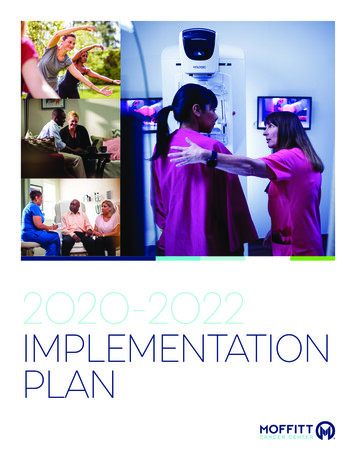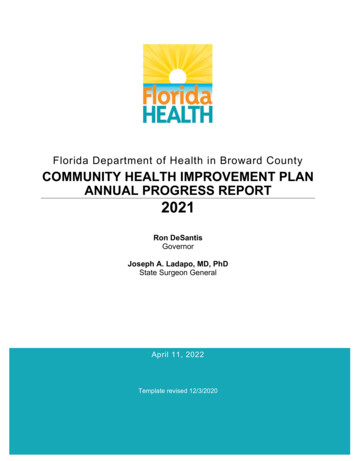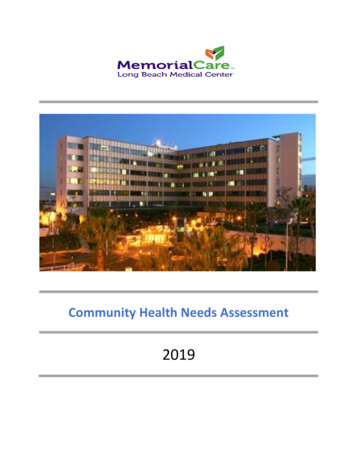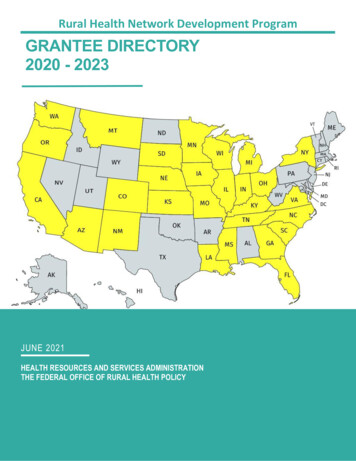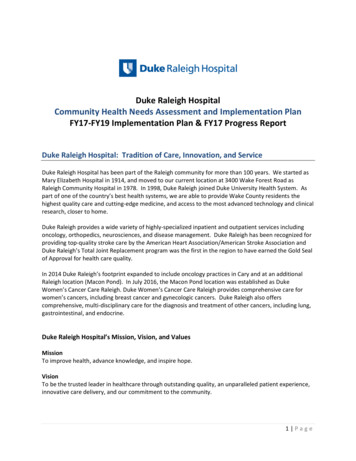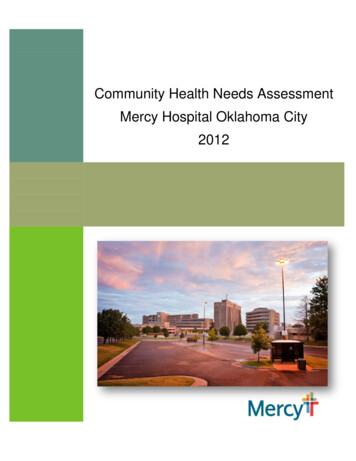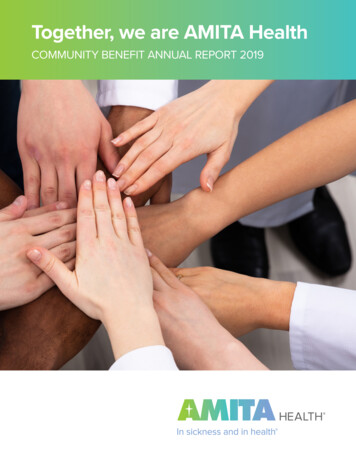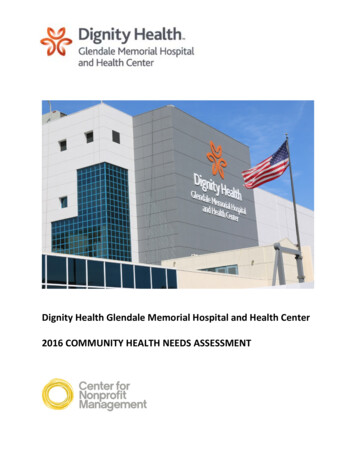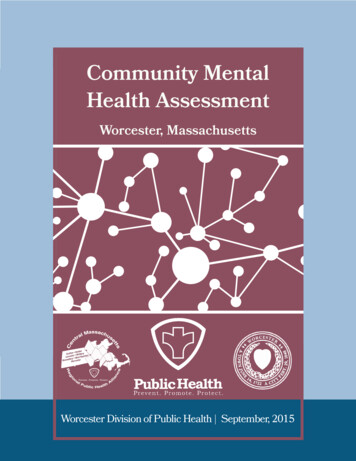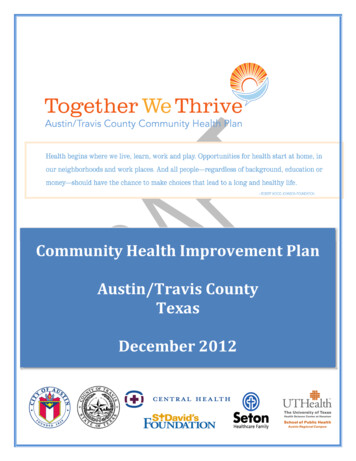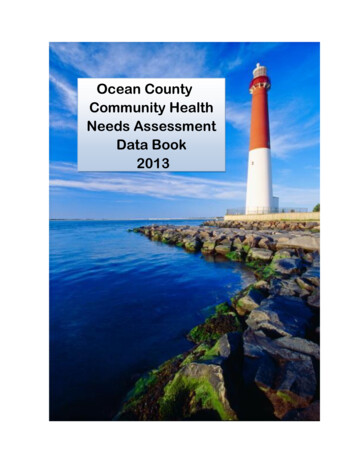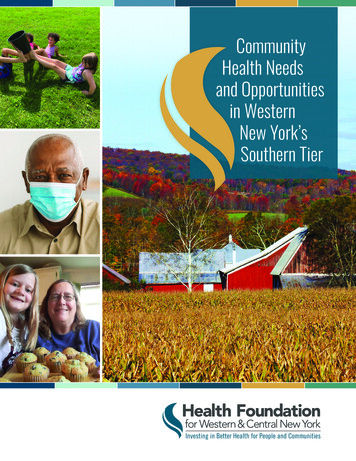
Transcription
CommunityHealth Needsand Opportunitiesin WesternNew York’sSouthern Tier
TABL E OF CONT ENT STable of ContentsA Letter from President Nora OBrien-Suric, PhD. . . . . . . . . . . . . . . . . . . . . . . . . . . . . . 2The People and Places of the Southern Tier. . . . . . . . . . . . . . . . . . . . . . . . . . . . . . . . 3Overarching Challenges and Barriers to Community Health . . . . . . . . . . . . . . . . . . . . . 5Challenges for Nonprofit Organizations and Service Agencies. . . . . . . . . . . . . . . . . . . 7A Closer Look at Existing Programs and Services . . . . . . . . . . . . . . . . . . . . . . . . . . . . 10Conclusions and Acknowledgments. . . . . . . . . . . . . . . . . . . . . . . . . . . . . . . . . . . . . 19Data Comparison by County. . . . . . . . . . . . . . . . . . . . . . . . . . . . . . . . . . . . . . . . . . . 20Health Foundation Theory of Change . . . . . . . . . . . . . . . . . . . . . . . . . . . . . . . . . . . . 23About the Health Foundation for Western and Central New York . . . . . . . . . . . . . . . . . 24
INTRO DU CTI O NTO O U R C O M M U N I T Y PA R T N E R S :In 2020, the Health Foundation for Western and Central New York launched a new strategicplan and vision with a focus on socioeconomic and racial health equity. To support thiswork, we commissioned a scan to identify opportunities for improving outreach efforts tothree rural counties in the Southern Tier of western New York—an area with vast healthneeds that have been historically under-resourced. We know that in order to betterunderstand and serve these communities, it is important to listen to and learn from thepeople who live, work and provide care there.The report, conducted by health care consultantsKate Ebersole and Sharon Mathe, provides anoverview of health care and community serviceresources and gaps in Allegany, Cattaraugus,and Chautauqua counties. Because the HealthFoundation’s strategic focus areas include olderadults, young children impacted by poverty,and community health capacity, this researchcentered around services for those specificpopulations and needs.The report’s findings make it clear that whilethese three counties are home to a rich, complex,and diverse community, overarching challengeslike health care access, lack of transportation andother infrastructure issues have a wide-reachingThe following is a highlight of the report’s keyfindings, and it is important to emphasize theinformation we capture here is only a snapshotof the work being led by a comprehensive,collaborative network of community-basedorganizations and health care providers.Thank you to the community service providerswho shared their time and input with us, andfor the dedication you continue to show tothe people you serve, especially in thesechallenging times.We hope that this information will supportongoing efforts to improve the lives andhealth of the people of the Southern Tier.and uniting impact on community health.The Health Foundation advocates for universalWith thanks,health coverage for all people in New York,and the information in this report underscoreshow critically important health care access is toimproving outcomes.Nora OBrien-Suric, PhDPresident2HEALTH FOUNDATION FOR WESTERN AND CENTRAL NEW YORK
ganyP E OP L E AND PLACESChautauquaCattaraugusAlleganyThe People and Placesof the Southern TierGEOGRAPHYAllegany, Cattaraugus and Chautauqua counties are known fortheir stunning ski hills, rolling farmland, and rugged forests. But inaddition to these typically rural landscapes, WNY’s Southern Tieris also home to cities such as Jamestown, Dunkirk, Salamanca,and Olean, and suburban settings surrounding these cities. Whilethe area’s reputation as an agricultural center remains true—over5,000 farms are located in the Southern Tier—the local economyis also home to several academic and research institutions, healthcare companies and other businesses.Allegany County is a geographically large rural area comprisedof 1,030 square miles and is located in the foothills of theAppalachian Mountains along the Pennsylvania border of NewYork State. The county has 29 townships and 10 villages, with themost populated communities being Wellsville, Alfred, Cuba andBolivar.SOUTHERN TIER COMMUNITY HEALTH NEEDS3
Cattaraugus County is a large (1309 sq. mi.), primarily rural county situated in southwestern New York, along thePennsylvania border. It is home to two cities, Olean and Salamanca, in addition to nine villages and 32 townslocated in Cattaraugus County.Chautauqua County is located in the southwestern corner of New York State, along the New York-Pennsylvaniaborder, and is the westernmost of New York’s counties. Chautauqua Lake is located in the center of the county,and Lake Erie is its northern border. Part of the Eastern Continental Divide runs through Chautauqua County.With two cities, Jamestown and Dunkirk, and twenty-seven towns and 15 villages, it covers 1,065 square miles.PEOPLEServing this region requires understanding the specificpopulation of over 8,000 enrolled members andculture, history and perspectives of those who liveis the fifth-largest employer in western New York.here, and how they can be more effectively reachedSeneca territory borders both banks of the Alleghenywith comprehensive resources and support.New York’s Southern Tier is the northernmost partof Appalachia, the cultural region that stretches southinto Alabama and Georgia. Most of the earliest settlersin Appalachia came from Scotch-Irish or Germanbackgrounds. As in many other parts of Appalachia,River and is partially within several of the towns inthe southern part of the county (South Valley, Cuba,Cold Spring, Salamanca, Great Valley, Red Houseand Carrollton, with a very small portion in the townof Allegany). The City of Salamanca, with the exceptionof a northern spur along U.S. Route 219, is also locatedthe people of this region are known for having strongwithin Seneca territory.family and community ties. Appalachian residentsLong-established Black communities exist in Jamestown,are also frequently subject to unfair stereotypingand mischaracterization, and many have weatheredgenerations of economic struggle.While the majority of people in Allegany, CattaraugusDunkirk, Riceville and Olean. Black people make up2.8 percent of Chautauqua County residents, primarilyin Jamestown and Dunkirk, while those in the Ricevilleand Olean areas represent 1.5 percent of those living inand Chautauqua counties are white, there are small butCattaraugus County.established communities of people of color throughoutThe three counties are home to small but growingthe region. This section provides a brief overview of thecommunity’s cultural diversity, and specific data on theracial makeup of the area is available at the end of thereport.communities of immigrants and refugees, includingHispanic communities in Jamestown, Dunkirk andSalamanca; Vietnamese immigrants in Olean inCattaraugus County, and Chinese immigrantsWNY’s Southern Tier is home to three Seneca Nationthroughout all three counties.territories. The Seneca are the largest of six NativeAll three counties have significant and growing AmishAmerican nations comprising the Haudenosauneeor Iroquois Confederacy or Six Nations, a democraticgovernment that pre-dates the United StatesConstitution. Today, the Seneca Nation has a4HEALTH FOUNDATION FOR WESTERN AND CENTRAL NEW YORKpopulations. Population counts for this group areestimated because most of the Amish community doesnot participate in the U.S. Census, nor in public orprivate health insurance programs.
C H AL L ENGE S AND BARRIERSOverarchingChallengesand Barriersto CommunityHealthPOVERTYThere are several factors that have an impact on the health of people in the Southern Tier. The most significant ofthose is the impact of poverty. These counties have some of the highest poverty rates in New York State.In2019,the poverty rate inChautauquaCountywasover18%AlleganyCounty,in CattaraugusCounty,17% 16.5%while theNEW YORK STATEAVERAGE was14%The need for safety net programs or community services to meet the needs of those affected by poverty is significant in this area.Income-related health disparities are well documented.These counties also have comparatively high ratesPoverty is strongly associated with poorer healthof people without insurance coverage. The 2019outcomes for complex reasons related to the socialU.S. Census showed that Allegany and Chautauquadeterminants of health: lack of access to health care,counties both had uninsured rates over 5 percent, andtransportation, healthy food and other social orthe rates in Cattaraugus County were even higher—environmental factors. Being in poor health also makesnearly 7 percent. While the number of insured peopleit harder to find or keep work, a negative feedback loophas improved significantly since the passage of thesometimes referred to as the health-poverty trap.Affordable Care Act in 2010, there are still many peoplewithout adequate or affordable health coverage.SOUTHERN TIER COMMUNITY HEALTH NEEDS5
POOR TRANSPORTATION INFRASTRUCTURE was continually mentioned by Southern Tierresidents as a major obstacle to good health. The rural nature of the area makes it difficult for individuals withoutaccess to a car or truck to travel for health care, and public transportation options are very limited. This is in linewith national data: a 2019 poll by NPR, the Robert Wood Johnson Foundation, and the Harvard T.H. Chan School ofPublic Health showed that 25 percent of people living in rural areas across the country weren’t able to get neededhealth care, and that approximately one-quarter of these respondents said that the reason they weren’t able to wasbecause the location was either too far or too difficult to get to.This lack of transportation in rural settings can not only make it difficult for residents to access health care servicesbut can also lead to increased rates of social isolation and loneliness. Older adults, especially those who also facemobility issues, are at great risk for social isolation and loneliness. The COVID-19 pandemic and resulting socialdistancing measures have only exacerbated these issues.HEALTH CARE PROVIDERSA lack of health care providers is as an ongoing issue forto struggle to effectively do so until broadband isthese regions. All three counties are Health Professionalmore readily available.Shortage Areas (HPSA) as designated by the U.S. HealthResources and Services Administration, meaning theseHOUSINGareas have a shortage of primary, dental and/or mentalThere is a need for increased safe, affordable housinghealth care providers. These shortages, especially whencompounded with the other issues noted previously, makeit even more difficult for residents to access health care.Because of this shortage, many people have troubleaccessing care for physical disabilities and/or behavioralhealth issues in the region. In a survey done in2017, people living with at least one disability in theCattaraugus region were asked about barriers to betterhealth, and the overwhelming number one answer wasoptions for older adults and for others living in povertyin this region. Low-cost apartment and/or assisted livingdevelopments are either rare or non-existent. Mostolder adults would prefer to remain in their own homesbut may not have the financial or physical ability to doso. The region’s community action organizations havehousing programs, but they are limited in scope andsome only focus on weatherization solutions.mental health issues. Many people face significant waitFAMILY CAREGIVER NEEDStimes in accessing primary or specialized care due toThere is a need in these counties, as there is across thethese shortages.country, for greater family caregiver support. Familycaregiving of all kinds has become more prevalentBROADBANDThe lack of broadband connectivity is a long-timeregional problem that has worsened several otherissues during the pandemic, including social isolationand efforts to expand telehealth—two issues thatfrequently have an impact on older adults andtheir caregivers. Health systems that would like toexpand telehealth have struggled and will continue6HEALTH FOUNDATION FOR WESTERN AND CENTRAL NEW YORKin recent years due to an aging population, ongoingeconomic challenges, and poor access to paid homecare options. In addition to more traditional forms ofcaregiving, a significant number of grandparents inthis region are serving as primary caregivers for theirgrandchildren. Kinship caregivers often have troubleaccessing resources and respite opportunities tohelp them deal with the mental, physical, financial oremotional stress that comes with that role.
C H AL L E NGE S AND B ARRIERSChallenges for Nonprofit Organizationsregion with extensive poverty like the Southern Tier,and Service Init isa criticallyimportant to have a strong network of safetyAgencies net and community-based organizations to meet people’sneeds. But those needs are vast, and nonprofit organizationsface several ongoing challenges.FINANCIAL AND WORKFORCEInsufficient funding is a serious challenge for nonprofit organizations in theSouthern Tier. While some larger nonprofits have sustainable funding, for themost part these organizations must either align with an ongoing funding sourcesuch as the school systems or constantly fundraise to continue operating.Many agency executives who were surveyed estimated that between 75 and80 percent of their time is spent writing grants or fundraising in some form.This focus on keeping the doors open can limit an organization’s ability toimprove or expand programming, such as training on trauma-informedprinciples or greater emphasis on social-emotional learning.SOUTHERN TIER COMMUNITY HEALTH NEEDS7
ALICE FAMILIES AND THE NONPROFIT ECOSYSTEMALICE is an acronym for Asset Limited, IncomeESPRI (Empire State Poverty ReductionConstrained, Employed. These are householdsInitiative), through the United Way ofthat earn above the Federal Poverty Level, butSouthern Chautauqua County, is leadingnot enough to afford basic household needs.a long-term effort to reduce the numberFor far too many families, the cost of livingof ALICE families in the Jamestown area byoutpaces what they earn.identifying and addressing workforce issues.A SSETLIMITED,INCOMECONSTRAINED,EMPLOYEDThis work inadvertently highlighted the ongoing struggles of the region’snonprofit ecosystem: during this initiative, nonprofit agencies that wereinvolved in the work reported that many of their employees delivering theservices for ESPRI were themselves in ALICE families.Child care programs very frequently face financialchallenges. Many of the smaller child care operatorshave closed during the pandemic, and several of thelarger child care centers operate at a loss. Most of thechild care centers that remain open are associated witha larger organization such as the YMCA, the YWCA orthe community action organizations.A corresponding challenge is workforce issues. Thefunding situation creates an environment where payrates in nonprofits are significantly lower than in thefor-profit sector. Executive directors in many nonprofitsmake under 75,000 even if they are running anorganization with 25 – 100 employees. Low wagesand high stress lead to frequent turnover and difficultyrecruiting new talent.Additionally, the region experiences a “brain drain”with students from the area leaving the Southern Tier toobtain higher pay in other areas. This in turn causes ashortage of qualified, educated workers to fill positionsin health care and nonprofit organizations.8HEALTH FOUNDATION FOR WESTERN AND CENTRAL NEW YORKREPAIRING TRUST IN HEALTHCARE SYSTEMSA significant problem crossing racial and cultural linesis a lack of trust in health care systems. This distrust isoften rooted in the historical barriers to care faced bymany people living in poverty. People frequently trustthose in their inner circle—friends or family—beforelistening to health care providers.
The financial burden of health care, especiallyfor those without insurance coverage, alsocontributes to these feelings of distrust. Thosewho are uninsured or underinsured are oftenunderstandably wary to seek care due to theexpected cost or previous experiences withmedical debt and surprise billing.Language and cultural barriers are an ongoingchallenge for many service providers who areworking to reach immigrant populations in thisarea. According to those surveyed, Chineseimmigrants locally tend to not seek out safetynet programs or services. Some of these familiessend their children to New York City to live withrelatives due to bullying and lack of languageassistance and support in the local school systems.Many Vietnamese immigrants in Olean movefrequently, within the city or to other regions,making it difficult for service providers to reachthem. Both the YMCA of the Twin Tiers andthe Cattaraugus County Department of Aginghave ongoing efforts to reach these families,particularly mothers and young children whomay benefit from support services.Members of Jamestown’s Black communitynoted an ongoing difficulty accessing supportfrom nonprofits and other service providers—abarrier that also contributes to distrust in thesesystems. Service providers surveyed for thisreport noted that many members of the Blackcommunity have expressed that they have beenliving here for generations but feel their needshave not been met by organizations working withother populations in need. One woman fromJamestown stated “The nonprofits all come touse our demographics but we never see any ofCOMMUNITY ORGANIZATION SPOTLIGHT:Universal Primary CareBrett Lawton is Chief Executive Officer of UniversalPrimary Care, a Federally Qualified Health Centerserving Cattaraugus, Allegany and McKean counties.He shared his thoughts about current health careaccess challenges in the Southern Tier, and thestrengths he sees in community health in this region:“It’s important to remember that poverty and socialdeterminants of health are the same challenges that affectboth rural and urban America. I feel like the big challengeis misinformation and the political divide that leavespeople mistrusting of the health care community anddeters them from having a relationship with us. Also, thelack of transportation provides a huge obstacle for a lot ofresidents. The lack of specialty care in the Southern Tieralso keeps residents from being able to access the kind ofcare they need. It leaves them having to travel to Buffalofor specialty care, which can’t always happen becauseof the transportation barrier.There really is a need for behavioral health services.I think trauma with poverty looks a little different here– as opposed to urban areas – and it sometimes goesunrecognized.I’m really impressed – being a city guy – with how laterallyinformed service providers are given the distance betweenthem. The people are so well connected here and it’s anasset that they know how to navigate. I do think thereis a network of organizations working together towardcommon goals and there’s a sense of coming together forthe greater good.”the money from the grants they then get.”SOUTHERN TIER COMMUNITY HEALTH NEEDS9
A Closer Look at Existing Programs and Services he following information summarizes the health care and community serviceTlandscape in Allegany, Chautauqua and Cattaraugus counties; it is not intendedto be an exhaustive list of organizations.HEALTHNETWORKS,FQHCS ANDPRIMARY CAREPROVIDERSRural Health Networks: There are four rural health networks in this region that workfrequently as collaborative partners. Each leads multiple programs to address accessto health care and community needs.Healthy Community Alliance, based in Gowanda, is the most geographicallywidespread network. HCA does work regionally and along the route 39 corridor,which includes Cattaraugus, Erie and Wyoming counties. HCA is the founder of the48-county CBO Consortium of upstate New York.Southern Tier Health Care System (STHCs) works across the Southern Tier withemergency management organizations. With support from a grant from the HealthFoundation, STHCs also leads Safe Kids Southern Tier New York, providing dedicatedand caring staff, operation support and other resources to assist in achieving the goalof keeping kids safe. Based on the needs of the community, this coalition implementsevidence-based programs, such as car-seat checkups, safety workshops and sportsclinics, that help parents and caregivers prevent childhood injuries.Ardent Solutions, serving Allegany, Chautauqua, Cattaraugus and Steuben counties,is noted for their local, regional and state-wide collaborations especially in addressingnumerous community health outcomes, age-friendly design and mobility options.Ardent also helps lead Trauma Informed Care Throughout Allegany County, orTICTAC, a collaborative effort to equip service providers with trauma-informed careprinciples. This work is supported through the Health Foundation’s Co-Creating WellBeing program.In Chautauqua County, the former Chautauqua County Health Network was renamedto Chautauqua Health Network. The network is now largely focused on primary carepractices and hospitals, with less focus on community outreach.10HEALTH FOUNDATION FOR WESTERN AND CENTRAL NEW YORK
Primary Care and Hospitals: As noted previously,Cattaraugus County locations; Jones Memorial Medicalthere is a general shortage in this region of primary carePractices; and Olean Medical Group.providers and specialists, with most of the specialistslinked to either the hospital systems or several largeprimary care organizations, most of them either FederallyQualified Health Centers or FQHC look-alikes. FQHClook-alikes are community-based health care providersthat meet the requirements of the HRSA Health CenterProgram, but do not receive Health Center Programfunding.Hospitals include Upper Allegany Health System inOlean and Bradford, PA., (affiliated with Kaleida Health);Bertrand Chaffee Hospital in Springville (affiliated withCatholic Health System); Cuba Memorial (affiliatedwith Kaleida Health), an urgent care hospital in Cuba;University of Pittsburgh Medical Center Chautauqua(UPMC) in Jamestown; and Jones Memorial in Wellsville(affiliated with University of Rochester Medical Center inThe main primary care organizations in Cattaraugusand Allegany Counties are Universal Primary Care, anFQHC with offices in Olean, Houghton, Salamanca,and Cuba; Tri-County Medicine in Gowanda; an FQHClook-alike that is expanding into Allegany County; OleanGeneral Hospital’s four primary care centers in variousRochester).The major primary care center in Chautauqua County isthe Chautauqua Center, an FQHC that serves allof Chautauqua County. They work closely withBrooks-TLC Hospital System in Dunkirk and withUPMC Chautauqua in utionsPictured: Signs created byArdent Solutions/Age-FriendlyAllegany County Committee tocheer older adult residents andworkers during the pandemic.Ardent Solutions is a rural health network serving Allegany, Chautauqua,Cattaraugus and Steuben counties. Executive Director Carrie Whitwoodshared the following about the regional landscape and challenges.“Some of the greatest challenges in ourand positively impact those needs. It reallyregion are around the social determinantsaccentuated some of the challenges thatof health. The pandemic has challengedwe had been facing, and it became criticalus in many ways and caused exceptionalthat we put in place solutions to addressdifficulties in communities with limitedthem. Organizations were able to adjustresources including increased financialpretty quickly to virtual meetings and toinstability, food insecurity, housingprovide telehealth services; though we stillinstability and less access to preventivehave the difficulty of not having broadbandhealth care services. It also took a toll oncoverage in many rural areas in themental health with an increase in stress,communities we serve.social isolation with restrictions on traveland gathering, academic and businessclosures, stay at home orders, and lackof access to food and services. Thesechallenges brought together health andhuman service providers who workedcreatively and collaboratively to addressAllegany County has one of the lowestvaccination rates in the state, and wecontinue to work together to educateand build community capacity againstthe spread of the disease, testing, and11SOUTHERNTIER COMMUNITYHEALTH NEEDSthe importanceof vaccination.”
EXIS T IN G P R O G R A MS A N D S ERVIC E SCOLLABORATIONS, PARTNERSHIPSAND SUPPORT NETWORKS FOR PROVIDERS:Collaboration and coordination among service providers is more important thanever as the pandemic has strained resources and funding and made traditionalforms of service delivery more difficult. Although the sprawling geography in theSouthern Tier can impede these partnerships, most of the organizations surveyednoted there is a strong spirit of collaboration among many service providers, andthat the challenges of the pandemic have led to more opportunities for agenciesto work together and share information.In Chautauqua County, the CHAT (ChautauquaHealth Action Team) serves as a quarterly roundservices varies from county to county. Chautauquatable for discussions about what is happeningCounty has organized efforts in this area, witharound the county within the nonprofit sectors.the maternal and child health initiative from theCattaraugus County’s Healthy Livable CommunityConsortium is a gathering of all sectors, includingnonprofits, government, schools, businesses,faith-based and consumers for the purposesof gathering and sharing information.Allegany County offers the Allegany AgencyExchange meetings that serve as a forum forupdates and information sharing.Health and Human Services Department and theChild Care Council that is run by the communityaction organization Chautauqua Opportunities(COI). In Allegany County, ACCORD, a communityaction organization and Ardent Solutions,a rural health network, collaborated to formthe Early Childhood Education Council.In all three counties, Head Start serves as a mainservice provider for children zero through five.In each of the three counties, the Office forThe YMCA of the Twin Tiers in Olean andAging is the main organization working withWellsville uses child care services as a path toolder adults and stewarding collaborativeengaging low-income families.efforts among providers.12The coordination of maternal and child healthHEALTH FOUNDATION FOR WESTERN AND CENTRAL NEW YORK
SERVICES AND PROGRAMS FOR OLDER ADULTSThe pandemic has had asignificant impact on thealready-struggling networkof services for older adultsin this region, especially dueto previously-mentionedinfrastructure issues suchas transportation andbroadband access.The main agencies leading care and coordination of services for older adults in this regionare the counties’ Offices for the Aging (OFA). The Alzheimer’s Association works closelywith the OFAs in each county, as do the community action organizations, Departments ofSocial Services and rural health networks, among others.Several organizations are working on innovative approaches to address the issues affectingolder adults in the region, including social isolation and caregiving needs.Services like Meals on Wheels continue to play an important role in helping older adultsstay both physically and mentally healthy and help mitigate the impact of social isolation.Congregant dining and other social outing programs faced significant obstacles duringthe pandemic for safety reasons, and most had to pause services temporarily, but manyre-started after vaccination efforts began.Exhale, the Family Caregiver Initiative, funded by the Health Foundation and the RalphC. Wilson, Jr. Foundation, is funding collaborative projects to increase community-basedrespite opportunities for family caregivers of older adults. The pilot of this effort, led byThe Philanthropic Initiative, originally launched in four Southern Tier counties: Allegany,Cattaraugus, Chautauqua, and Wyoming, and will soon expand in Erie, Niagara, Genesee,Orleans, Wyoming, and Monroe.SOUTHERN TIER COMMUNITY HEALTH NEEDS13
To support the increasing number of grandparents whoare taking on the role of caregiver to their grandchildren,a Relatives as Parents Program is being led in theSouthern Tier by Catholic Charities and the YMCA ofthe Twin Tiers, with funding from the Health Foundationand the Brookdale Foundation. These programs providesupport, guidance and respite opportunities for grandparentsor other relatives who serve as the main caregiver for childrenwhose biological parents are unable to provide that care.There are continuing efforts in all three counties toincorporate age-friendly practices. Age-friendly initiativeshelp build safe, healthy communities where all peopleCOMMUNITY ORGANIZATION SPOTLIGHT:can age with dignity through a collaborative, cross-sectorSouthern Tier HealthCare System, Inc.approach that recognizes how social factors have animpact on health.Ardent Solutions is leading a collaborative effort in AlleganyCounty to be part of the AARP Network of Age-FriendlyCommunities. The Age-Friendly Allegany County initiativeis a five-year program cycle that includes a county-wideassessment survey and three-year workplan to develop newefforts to make Allegany County communities healthier forresidents of all ages and abilities.“In Cattaraugus and Chautauqua counties, age-friendly effortsare being led among several local partners. Aging-in-placeinitiatives like Enchanted Mountain Village in CattaraugusCounty and Community Connections at Findley Lakein Chautauqua
WNY's Southern Tier is home to three Seneca Nation territories. The Seneca are the largest of six Native American nations comprising the Haudenosaunee or Iroquois Confederacy or Six Nations, a democratic government that pre-dates the United States Constitution. Today, the Seneca Nation has a population of over 8,000 enrolled members and
